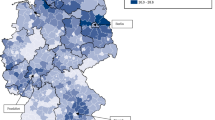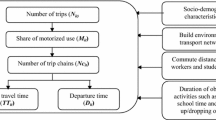Abstract
This paper assumes that activities at the home and work location are important determinants of individuals' paths through time and space. Fixed activities at these locations determine to a large extent the duration and timing of time windows – blocks of time available for participation in travel and out-of-home non-work activities. Taking the time spent at home and at the workplace as a starting point, this paper classifies activity patterns on workdays into six groups with distinct home- and work-stay patterns. For this, data are used from the 1998 Netherlands National Travel Survey. The six clusters vary in terms of the duration and timing of time windows and some of the differences can be explained by commute characteristics, types of non-work activities performed, workers' sociodemographic attributes, and their spatiotemporal environment. However, the impact of sociodemographic and spatiotemporal variables on cluster membership is shown to be weak.
Similar content being viewed by others
References
Bhat CR & Singh SK (2000) A comprehensive daily activity-travel generation model system for workers. Transportation Research A 34: 1–22.
Breedveld K (2000) The double myth of flexibilization: trends in scattered work hours and differences in time-sovereignty. Time & Society 7: 129–143.
Burns LD (1979) Transportation, Temporal and Spatial Components of Accessibility. Lexington, Massachusetts: Lexington Books.
Chapin Jr FS (1974) Human Activity Patterns in the City: Things People Do in Time and Space. New York: John Wiley & Sons.
Cullen I & Godson V (1975) Urban networks: the structure of activity patterns. Progress in Planning 4: 1–96.
Damm D (1979) Toward a Model of Activity Scheduling Behavior. Cambridge, MA: Massachusetts Institute of Technology.
Dijst M & Vidakovic V (2000) Travel time ratio: the key factor in spatial reach. Transportation 27: 179–199.
Ettema D, Borgers A & Timmermans H (1993) Simulation model of activity scheduling behavior. Transportation Research Record 1413: 1–11.
Forer PC & Kivell H (1981) Space-time budgets, public transport, and spatial choice. Environment and Planning A 13: 497–509.
Gifi A (1990) Nonlinear Multivariate Analysis. Chichester: John Wiley & Sons.
Golob TF (1986) A nonlinear canonical correlation analysis of weekly trip chaining behavior. Transportation Research A 20: 385–399.
Golob TF (1998) A model of household choice of activity participation and mobility. In: Gärling T, Laitila T & Westin K (eds) Theoretical Foundations of Travel Choice Modeling (pp. 365–398). Oxford: Pergamon.
Hanson S & Huff JO (1986) Classification issues in the analysis of complex travel behavior. Transportation 13: 271–293.
Hägerstrand T (1970) What about people in regional science? Regional Science Association Papers 24: 7–21.
Joh C-H, Arentze T, Hofman F & Timmermans H (2002) Activity pattern similarity: a multidimensional sequence alignment method. Transportation Research B 36: 385–403.
Jones PM, Dix MC, Clarke MI & Heggie IG (1983) Understanding Travel Behaviour. Aldershot: Gower.
Kaufman L & Rousseeuw PJ (1990) Findings Groups in Data: An Introduction to Cluster Analysis. New York: John Wiley & Sons.
Kitamura R (1983a) Sequential, history-dependent approach to trip-chaining behavior. Transportation Research Record 944: 13–22.
Kitamura R (1983b) Serve passengers trips as a determinant of travel behavior. In: Carpenter S & Jones P (eds) Recent Advances in Travel Demand Analysis (pp. 137–162). Aldershot: Gower.
Kitamura R & Fujii S (1998) Two computational process models of activity-travel choice. In: Gärling T, Laitila T & Westin K (eds) Theoretical Foundations of Travel Choice Modeling (pp. 251–279). Oxford: Pergamon.
Kitamura R, Yamamoto T, Kishizawa K & Pendyala RM (2000) Stochastic frontier models of prism vertices. Transportation Research Record 1718: 18–26.
Kitamura R, Akiyama T, Yamamoto T & Golob TF (2001) Accessibility in a Metropolis: Toward a Better Understanding of Land Use and Travel. Presented at the 80th Annual Meeting of the Transportation Research Board, Washington, DC, January 7–11 2001.
Kondo K & Kitamura R (1987) Time-space constraints and the formation of trip chains. Regional Science and Urban Economics 17: 49–65.
Kwan M-P (1998) Space-time and integral measures of individual accessibility: a comparative analysis using a point-based framework. Geographical Analysis 30: 191–216.
Kwan M-P (2000) Gender differences in space-time constraints. Area 32: 145–156.
Kwan M-P & Hong X-D (1998) Network-based constraints-oriented choice set formation using GIS. Geographical Systems 5: 139–162.
Lenntorp B (1976) Paths in Space-Time Environment: A Time-Geographic Study of Movement Possibilities of Individuals. Lund: The Royal University of Lund, Department of Geography.
Maw R (1971) Construction of a leisure model. Ekistics 184: 230–238.
Miller HJ (1991) Modelling accessibility using space-time prism concepts within geographical information systems. International Journal of Geographical Information Systems 5: 287–301.
Nishii K & Kondo K (1992) Trip linkages of urban railway commuters under time-space constraints: some empirical observations. Transportation Research B 26: 33–44.
Pendyala RM, Yamamoto T & Kitamura R (2002) On the formation of time-space prisms to model constraints on personal activity-travel engagement. Transportation 29: 73–94.
Schwanen T, Dieleman FM & Dijst M (2001) Travel behavior in Dutch monocentric and policentric urban systems. Journal of Transport Geography 9: 173–186.
Statistics Netherlands (1999) National Travel Survey 1998: Documentation for Tape Users [in Dutch]. Voorburg/Heerlen: Statistics Netherlands.
Ter Braak CJF (1990) Interpreting canonical correlation analysis through biplots of structure correlations and weights. Psychometrika 55: 519–531.
Van der Burg E & De Leeuw J (1983) Non-linear canonical correlation. British Journal of Mathematical and Statistical Psychology 36: 54–80.
Van Knippenberg C, Kockelkoren M & Korsten N (1990) Travel behaviour of non-traditional households. In: Jones P (ed) Developments in Dynamic and Activity-Based Approaches to Travel Analysis (pp. 123–144). Aldershot: Avebury.
Vidakovic V (1983) The second diary survey in Amsterdam: some intermediate results. In: Carpenter S & Jones P (eds) Recent Advances in Travel Demand Analysis (pp. 172–191). Aldershot: Gower.
Wilson WC (1998) Activity pattern analysis by means of sequence alignment methods. Environment and Planning A 30: 1017–1038.
Author information
Authors and Affiliations
Corresponding author
Rights and permissions
About this article
Cite this article
Schwanen, T., Dijst, M. Time windows in workers' activity patterns: Empirical evidence from the Netherlands. Transportation 30, 261–283 (2003). https://doi.org/10.1023/A:1023905020890
Issue Date:
DOI: https://doi.org/10.1023/A:1023905020890




